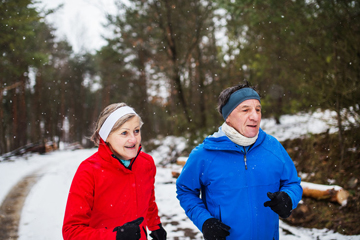Older adults should remain stay as active as possible, and exercise in a safe and healthy way. Physical activity can strengthen the body, ward off disease, boost mood, improve sleep, and much more. Outdoor activities are a great way for seniors to get some physical exercise. However, the cold and snowy weather can put a damper on outdoor fitness activities. Though winter is a beautiful time of year, snow, ice and cold temperatures can create challenging situations for anyone, especially seniors. Major two issues are:

- Cold weather can make older adults more susceptible to getting sick, and more vulnerable to infections.
- For those with medical conditions, long periods of cold weather poses several health risks such as heart strain, muscle injury, hypothermia, frostbite, and falls.
But that doesn’t mean seniors should not exercise. According to Harvard Health, “Despite the risks, exercising in cold temperatures does offer benefits that you don’t get in warmer weather. For example, exercising in the sunlight can help people who have seasonal affective disorder, a type of depression triggered by decreased exposure to daylight. And some evidence suggests that exposure to cold weather may help activate brown fat cells, which are known to burn calories.”
With proper planning and preparation, older adults can maintain their exercise routine even in cooler temperatures.
- Consult your doctor: If you have any kind of cardiovascular, lung, or balance issues, check with your doctor before exercising outdoors in the cold; know how you can exercise safely.
- Check the temperature and weather forecast: Before heading outside, check the temperature and forecast. If it’s extremely cold, rainy, snowy, or icy, skip your outdoor workout and exercise indoors.
- Choose the right time of day: In winter, stick to exercising during the warmest part of the day, such as around lunchtime, when the sun is at its peak.
- Don’t forget safety gear and sunscreen: Though it’s freezing outside, the sun’s UV rays can be just as harmful as in summer. So don’t forget to protect your skin, eyes and lips. Wear sunglasses to protect your eyes, use a broad-spectrum sunscreen with a SPF of at least 30 for skin and use lip balm with sunscreen to protect your lips.
- Cover up: Dress in layers and make sure you’re warm if you’re going outside. Bundling up in layers helps to be comfortable without getting overheated. If your body gets warmer with exercise, you can easily take off a layer and wrap it around your waist or put it in a small backpack. Wear athletic clothing, a hat, gloves, and heavy socks.
- Don’t overdo the exercise: Whether you are doing your usual exercises or starting a new regimen, don’t overdo it. Build the amount of exercise you do slowly. If you can’t manage 30 minutes in one go, break it up into 10-minute chunks.
- Warm Up: Whether it’s winter or summer, warm-up for up to 10 minutes before you start. This will help your body adjust to increased demands on the heart and to get blood and oxygen to the muscles. Walk at a brisk pace or jog to warm your muscles.
- Stay hydrated: Even when it’s cold outside, you’ll sweat and lose fluid when you exercise. So stay hydrated. Drink water before, during, and after your workout.
Top activities for older adults in winter include walking, yoga, and martial arts-inspired systems such as tai-chi and qi-gong. Walking requires no special equipment, aside from a pair of comfortable walking shoes, and can be done anywhere. If you cannot walk outdoors, you can do it indoors. Combining a series of poses with breathing, yoga improves strength, flexibility and balance, and can be adapted to any level. Tai chi and qi gong can increase balance and strength.
There are many senior-friendly exercises that can be performed indoors on days when snow and ice make exercising outdoors difficult. However, don’t ignore your body’s warning signs. If you’re shivering, have chest pain, are out of breath, or feel extremely fatigued, call for help immediately.